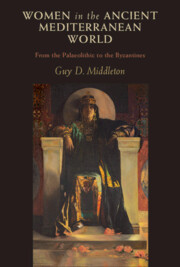Book contents
- Women in the Ancient Mediterranean World
- Women in the Ancient Mediterranean World
- Copyright page
- Dedication
- Epigraph
- Contents
- Preface
- Acknowledgements
- Timeline
- Historical Contexts
- Introduction
- Part I The Deep Past
- Part II The Bronze Age
- 4 Merneith
- 5 Šimatum and Kirum
- 6 The Woman of La Almoloya
- 7 The Priestess of Anemospilia
- 8 Hatshepsut
- 9 Puduhepa
- 10 Eritha and Karpathia
- 11 Hatiba
- Part III The Iron Age
- Part IV The Hellenistic Worlds
- Part V The Age of Empire
- Notes
- Select Bibliography
- Index
6 - The Woman of La Almoloya
from Part II - The Bronze Age
Published online by Cambridge University Press: 19 January 2023
- Women in the Ancient Mediterranean World
- Women in the Ancient Mediterranean World
- Copyright page
- Dedication
- Epigraph
- Contents
- Preface
- Acknowledgements
- Timeline
- Historical Contexts
- Introduction
- Part I The Deep Past
- Part II The Bronze Age
- 4 Merneith
- 5 Šimatum and Kirum
- 6 The Woman of La Almoloya
- 7 The Priestess of Anemospilia
- 8 Hatshepsut
- 9 Puduhepa
- 10 Eritha and Karpathia
- 11 Hatiba
- Part III The Iron Age
- Part IV The Hellenistic Worlds
- Part V The Age of Empire
- Notes
- Select Bibliography
- Index
Summary
Whilst not especially well known in Anglophone culture,1 the Early-Middle Bronze Age Spanish Argaric culture has long been regarded as important, sometimes even ‘the most important Bronze Age culture in Western Europe’, on a par with the better known Aegean cultures such as the Minoans, who were busy on Crete at the same time.2 Discovered in Victorian times by the Belgian Siret brothers, Louis and Henri, and named for the site at El Argar (in Antas, Almeria), the culture has perhaps suffered from the lack of a classical connection – unlike the Minoans and Mycenaeans there is no hint of them in later sources. Developing from around 2200 bc, the Argaric culture came to comprise several state-level polities that collapsed c. 1550 bc; this ending might have been welcomed by many, as Argaric society is thought to have been quite hierarchical and extractive, and the socio-political system it developed gladly and totally forgotten.3
- Type
- Chapter
- Information
- Women in the Ancient Mediterranean WorldFrom the Palaeolithic to the Byzantines, pp. 68 - 74Publisher: Cambridge University PressPrint publication year: 2023

